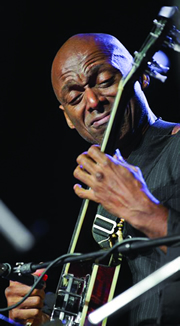Allegro
Sharing the Gift: Teaching Music in the Schools
Volume 114, No. 6June, 2014

Ayodele Maakheru
Photo: eddywestveer.com
That’s it really like to be a teaching artist in the New York City public schools? Ayodele Maakheru has been doing it for decades. A member of Local 802 since 1979, Mr. Maakheru plays guitar, banjo, bass, mandolin, ukulele, harmonica and djembe. He has performed, toured and recorded with everyone from Lionel Hampton to the New York Philharmonic. A partial list of his collaborators also includes Randy Weston, Ruth Brown, Eartha Kitt, Leslie Uggams, Phylicia Rashad, Gregory Hines, Miriam Makeba and the Rhythm Nation Band. He has played on Broadway for almost 30 years, was a featured soloist with the Clef Club Orchestra at Carnegie Hall and appeared on the Tonight Show with the band of “Bring in da Noise, Bring in da Funk.” He’s won the Bronx Council on the Arts BRIO award for music composition and an ASCAP award for composition. Local 802 organizer Miguel Santana caught up with Mr. Maakheru and asked him about working as a music teaching artist resident in the New York City public schools.
Miguel Santana: When people ask you why schools should spend money on teaching artists, what do you tell them?
Ayodele Maakheru: Ultimately I see this as a gateway for musicians to share their artistic knowledge with the next generation of musicians and audiences. Teaching artists show students the creative power that exists within them. Students learn self-discipline. Music itself is often a very effective vehicle for learning history, geography and social studies. Also, music literacy enhances math and science. Teaching lessons through songs improves one’s vocabulary and increases the retention of information. Unfortunately budget cuts in the New York City public schools often lead to cuts in the arts curriculum. This results in the need for outside grant-funded arts programs, such as teaching artists. I see the arts as salvation for a struggling educational system.
Miguel Santana: Why did you decide to become a teaching artist?
Ayodele Maakheru: About 20 years ago, several arts organizations began to partner up with schools, and also libraries and community centers. They reached out to me – as well as other performing artists – to help enrich public school education via the arts. Initially, it was an employment opportunity. However, as I evolved as a teacher and an artist, I realized that I am passionate about both disciplines.
Miguel Santana: How long do teaching artists work at a particular New York City public school?
Ayodele Maakheru: It’s usually two to six periods per day, at 45 minutes per period, on a weekly basis over the span of several weeks.
Miguel Santana: What do teaching artists need to know? What is their mission statement, so to speak?
Ayodele Maakheru: Teaching artists need to figure out how to pass their artistic gift forward. They should make a concerted effort to understand their students. They should develop a variety of options to assist students in finding their path to achieving a bright future. They have to be versatile in their format. For example, I’ve presented a wide variety of programs, including assembly performances, one-time workshops, choir and vocal residencies, instrument making, music history, composition and lyric writing, instrument instruction and ethnomusicology. Finally, teaching also keeps me constantly connected to my fundamental training in music.
Miguel Santana: What is the most important advice you would give to a young musician who wants to become a teaching artist?
Ayodele Maakheru: As a young musician, I possessed neither the experience nor patience to be a really good teacher. My focus was on performing and touring. After I traveled two-thirds of the world, played in many bands and orchestras, and became a parent, I realized that I have so much more to bring to a classroom. However, if a young artist recognizes the call to teach, then such passion should be motivation enough. I’d also like to suggest that young artists should collect method books of all types and levels. Attend professional development meetings and workshops. Sign on with arts-in-education resource groups. And volunteer some time teaching at your local community center or place of worship. I hope that everyone is able to find a way to share the gifts of their music.
